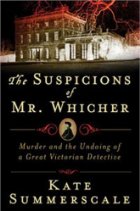
In true country-house-mystery fashion, The Suspicions of Mr. Whicher narrates the events surrounding a murder: the stabbing, throat-slitting, and possible suffocation of young Saville Kent, the four-year-old son of a middle-class family, one June night in 1860. True to form, the list of suspects narrows to the inhabitants of the house, all of whom have secrets to conceal, and, equally true to form, the savvy Scotland Yard detective is called to the scene after the local police make a muddle of things. Apart from being factual rather than fictional, there's not much about the Kent case that doesn't conform to the standard British whodunit formula...and that's just the point.
In fact, author Kate Summerscale argues that the Kent murder, and the media circus it inspired, were influential in the development of the murder mystery genre as we know it. Although the slaying followed Poe's The Murders in the Rue Morgue by several years, detective fiction was in its infancy when a member (or two?) of the Kent household slit little Saville's throat and stuffed his body down the privy. Summerscale points convincingly to a legacy of influence on books that came out during and after the investigation. She also traces the ways in which the "detective fever" surrounding the case, when every schoolmaster and greengrocer sent letters to Scotland Yard claiming to have solved the mystery, was capitalized on and extended by the avalanche of sensation novels of the 1860's and 70's. As a lover of Victorian literature, I found it fascinating to read about the fluctuations in public opinion surrounding detectives, detection, and the solving of murders, and how the familiar whodunit came into being.
Summerscale consistently takes Mr. Whicher beyond the bare-bones events of the days and months following the murder. The parts of the book in which she dissects the public reactions to the crime, and analyzes the social assumptions behind those reactions, were to me the most intriguing. Perhaps most notably she discusses how, by the mid-19th century, the sanctity and privacy of the middle-class home, the everyman's castle and sphere of the Angel in the House, had become a sacred by-word throughout England:
'Every Englishman...imagines a "home", with the woman of his choice, the pair of them alone with their children,' wrote the French scholar Hippolyte Taine after a visit to England in 1858. 'That is his own little universe, closed to the world.' Privacy had become the essential attribute of the middle-class Victorian family, and the bourgeoisie acquired an expertise in secrecy (the word 'secretive' was first recorded in 1853). They walled themselves in against strangers, the interiors of their homes almost invisible, except when opened by invitation to selected visitors for a staged show of family life - a dinner party, for instance, or a tea."
Understandably, then, "the horror of this case," for the general populace, "was that the corruption lay inside the 'domestic sanctum,' that the bolts, locks and fastenings of the house were hopelessly redundant." For many middle-class Brits, the facts of the Kent murder seemed to threaten an entire way of life. What if, instead of keeping their families safe, those high walls and cloistered drawing rooms were putting everyone in danger? What was it about the Kent family that led to such disaster? Many felt that, until the case was solved, there was no way of knowing that their own families wouldn't be next.
At the same time, the popular mania for privacy meant that people resented the need for an official intrusion across the sanctum's threshold. The police force, after all, was only thirty years old at the time: the people of England, wary of surveillance, had only allowed an official body of patrolmen since 1829, and the detective force was only established in 1842. People were still getting used to the idea of patrolling bobbies, let alone plain-clothes "spies" who insinuated themselves into every nook and cranny of a person's home. Detectives, as one period writer puts it, are "stained with vile associations, and unfit company for honest gentlemen." Not only are they drawn the lower classes, but their sneaking, near-villainous work makes them even more undesirable. So at the same time that newspaper articles were demanding that the Kent murderer be found, they also displayed a vicarious resentment on the Kent family's behalf at having to open the secrets of their family life to an outsider.
There are other points in Mr. Whicher when one set of social assumptions does battle with another. When, for example, Whicher arrests Constance, the sixteen-year-old daughter of the Kent family, the public is outraged that a man from the lower classes would be so brazen as to accuse a respectable middle-class girl, especially when the nursemaid, Elizabeth Gough, makes a much handier scapegoat. Indeed, certain periodicals go so far as to suggest that Whicher's crime against Constance is worse than the murder itself:
If Mr. Whicher's opinion was wrong, then beyond all question a crime infinitely exceeding in enormity the murder of Francies Saville Kent has been committed, from which, Constance, poor girl, will suffer till her dying day.
The idea that the very accusation of a potentially innocent girl "infinitely exceed[s] in enormity" the carving-up of a four-year-old child, and that she will suffer for it "until her dying day" is astounding, and revealing. The British public was accustomed to view crime as a character flaw of the poverty-stricken masses, not as something likely to be perpetrated by a virginal middle-class daughter. And the outrage at the very suggestion that Constance might be guilty makes a person wonder whether the writers of these articles would prefer, even if she had committed the crime, that lower-class folks like Jack Whicher refrain from nosing about the dirty laundry of the middle class.
Whicher's own assumptions, though, seem equally backward to a modern reader: he hears rumors that Constance's mother had gone insane while pregnant with her, and since madness was thought to pass almost infallibly from mother to daughter, Constance herself comes under suspicion. (Thomas Cooley suggests in his Ivory Leg in the Ebony Cabinet that simply being female in the absence of a strong male presence, as Constance would have been at her boarding school, was tantamount to insanity to the thinking of the period.) Neither set of underlying assumptions here - the classist scapegoating of a servant over a lady, or the sexist leap to female madness - are exactly admirable by modern standards, which makes for interesting reading when they go head-to-head.
I've seen some critiques of The Suspicions of Mr. Whicher for spending too much time on cultural and literary concerns peripheral to the nitty-gritty details of the actual crime, but to me, those same explorations were exactly what made the book fascinating. I might not recommend it to someone looking for a straight true-crime treatment, but for those interested in Victorian social or literary history, it's a quick, solid read that brings up a number of larger points while maintaining a lively narration of the Kent murder itself.
(The Suspicions of Mr. Whicher was my fourth book for the Dewey Decimal Challenge.)


I liked this book as well, and putting the mystery into the context of the Victorian era, as well as mystery novels (which I love) really made the book so solid.
Have you read any of Anne Perry's Thomas Pitt mysteries? He encounters a lot of the class issues, so I guess I wasn't as surprised at the suspisions Whicher was under as well.
The book really made me want to read The Woman in White, I must remember to look for that book.